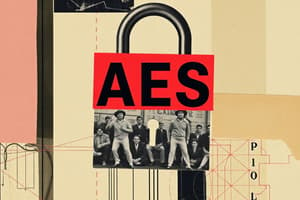Podcast
Questions and Answers
What is a critical factor that determines the security of an encryption algorithm?
What is a critical factor that determines the security of an encryption algorithm?
- The experience of the developer
- The number of encryption rounds used
- The strength of the encryption key (correct)
- The complexity of the algorithm structure
How many rounds does the AES algorithm use with a 256-bit key?
How many rounds does the AES algorithm use with a 256-bit key?
- 16 rounds
- 14 rounds (correct)
- 10 rounds
- 12 rounds
In which of the following sectors is AES not commonly used?
In which of the following sectors is AES not commonly used?
- Financial transactions
- Government communications
- Personal smartphone applications
- Manufacturing operations (correct)
What effect does increasing the key size have on the AES algorithm?
What effect does increasing the key size have on the AES algorithm?
Which statement accurately describes AES's strength against attacks?
Which statement accurately describes AES's strength against attacks?
What is the primary characteristic of AES as a symmetric-key encryption algorithm?
What is the primary characteristic of AES as a symmetric-key encryption algorithm?
What size of blocks does AES use for encryption?
What size of blocks does AES use for encryption?
Which transformation is NOT part of the AES round operations?
Which transformation is NOT part of the AES round operations?
How does the key schedule in AES contribute to the algorithm's security?
How does the key schedule in AES contribute to the algorithm's security?
Which operation is omitted in the last round of AES encryption?
Which operation is omitted in the last round of AES encryption?
What is the role of the S-box in AES?
What is the role of the S-box in AES?
In the decryption process of AES, what is done with the round keys?
In the decryption process of AES, what is done with the round keys?
What does the avalanche effect ensure in the context of AES?
What does the avalanche effect ensure in the context of AES?
Flashcards
AES's Security
AES's Security
AES's effectiveness against various attacks like brute force and differential cryptanalysis has been extensively analyzed and validated by rigorous security analysis.
What determines AES's Security?
What determines AES's Security?
The strength of AES is dependent on the security of the key used.
AES Practical Applications
AES Practical Applications
AES is widely used in diverse sectors for protecting sensitive information such as financial transactions and government communications.
AES Key Size
AES Key Size
Signup and view all the flashcards
AES Rounds
AES Rounds
Signup and view all the flashcards
What is a block cipher?
What is a block cipher?
Signup and view all the flashcards
What is the purpose of the key schedule in AES?
What is the purpose of the key schedule in AES?
Signup and view all the flashcards
What is the avalanche effect in AES?
What is the avalanche effect in AES?
Signup and view all the flashcards
Explain byte substitution in AES.
Explain byte substitution in AES.
Signup and view all the flashcards
Explain the shift rows operation in AES.
Explain the shift rows operation in AES.
Signup and view all the flashcards
Explain the mix columns operation in AES.
Explain the mix columns operation in AES.
Signup and view all the flashcards
How is the encryption key used in AES?
How is the encryption key used in AES?
Signup and view all the flashcards
What is the relationship between the encryption and decryption processes in AES?
What is the relationship between the encryption and decryption processes in AES?
Signup and view all the flashcards
Study Notes
Overview of AES
- AES (Advanced Encryption Standard) is a widely used symmetric-key encryption algorithm.
- It's a block cipher, encrypting data in fixed-size blocks.
- AES operates on 128-bit blocks.
- Key sizes are 128, 192, or 256 bits.
- It's a substitution-permutation network (SPN) algorithm.
Key Scheduling
- AES uses a key schedule to derive round keys from the encryption key.
- The schedule creates unique round keys for each round.
- The key schedule ensures the avalanche effect, where slight key changes lead to significant ciphertext changes.
- The process involves multiple key transformations.
- Each round uses a unique round key, enhancing security.
Rounds and Transformations
- AES uses multiple rounds of operations.
- Key additions, byte substitution, shift rows, and mix columns are the core transformations.
- Each round uses one or more transformations, forming the SPN structure.
- Byte substitution replaces values in the state matrix using a substitution box (S-box).
- Shift rows shifts bytes in different rows of the state matrix by varying offsets.
- Mix columns uses matrix multiplication to mix bytes in different columns.
- These transformations process plaintext blocks and round keys through the encryption algorithm.
The Encryption Process
- Input plaintext is divided into blocks.
- The encryption key is used in the key schedule to generate round keys.
- The algorithm initially adds the first round key to the plaintext.
- The repeated round transformation process continues for a number of rounds based on the key size.
- The final round omits the mix columns operation.
- The output is the ciphertext from the final round.
Decryption Process
- Decryption inverts the encryption process's operations.
- Round keys are derived in reverse order.
- Inverse operations are applied in reverse order, including the inverses of substitution, shift rows, and mix columns.
- The decryption process mirrors the encryption algorithm.
- This reversibility is a key aspect of the algorithm's functionality.
Security Considerations
- AES security comes from its complex design and the avalanche effect.
- The design resists various cryptanalysis techniques.
- Rigorous security analysis validates AES's strength against attacks.
- AES has proven resistant to various attacks.
- Key security is crucial to any encryption algorithm's strength.
Practical Applications
- AES is widely used across sectors.
- It secures sensitive data like financial transactions and government communications.
- It is essential in many cryptographic systems and protocols.
- AES's efficiency and robustness allow widespread use in applications.
Variations for Different Key Sizes
- Key sizes affect the number of rounds.
- 128-bit keys use 10 rounds, 192-bit keys use 12 rounds, and 256-bit keys use 14 rounds.
- More rounds enhance security, providing better attack resistance for larger key sizes.
Studying That Suits You
Use AI to generate personalized quizzes and flashcards to suit your learning preferences.



